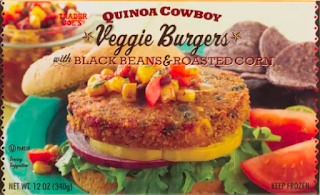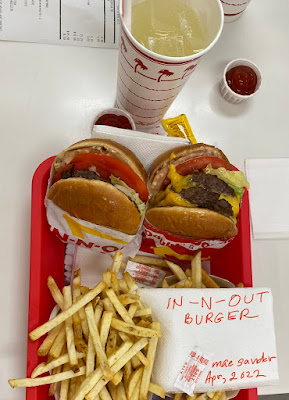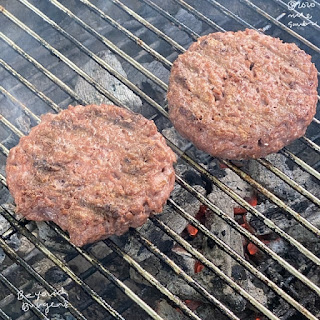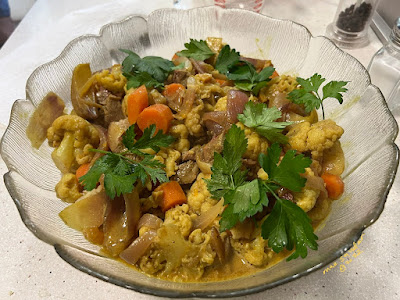 |
From Burger King's Menu, May 2022: Impossible Whoppers.
I have tried them and they are fine. |
"Beyond and Impossible meats are two different brands of plant-based meats that taste exactly like real meat—or close enough. The Impossible Burger even "bleeds" like meat, and is made mostly from soy, coconut oil, sunflower oil and natural flavors. Beyond Meat's key ingredients include water, pea protein, expeller-pressed canola oil, refined coconut oil and rice protein." (Source: Is Impossible Meat Bad for You?)
 |
Home-made Impossible Meatballs.
Some comments last week asked about what they are. |
Last week I wrote about preparing and eating Impossible meatballs. I had found the key ingredient, Impossible Beef, at Trader Joe's -- it's popular so they do not always have it in stock. We've also tried Beyond Burgers; however, after using them for a while, I no longer enjoyed them. So far, I do like Impossible Meat, which I find a very convincing meat substitute, and better than vegetarian patties. While some people find just the idea of such products repellant, I am open to experiments!
 |
A less-meat-like meat substitute: veggie burgers.
Not bad, just not like meat. |
I’ve written before about our decision to buy less meat, and how we have switched our diet to a combination of plant-based foods, dairy products, some fish, and occasionally chicken. I’ve described how our reasons originally involved concern for human rights violations and inhumane treatment of workers in slaughter houses and meat-packing plants, which were especially abusive during the first months of the coronavirus pandemic. We also considered other reasons to eat less meat, including the negative impact of cattle and hog raising on the global environment, the effect of eating meat on our health, and issues of cruelty to animals throughout the industrial meat-farming and slaughtering process. Switching to imitation meat addresses most of these problems.
 |
One thing we try to give up: Fast Food like In-N-Out Burgers.
Shown here with lemonade to share with Elizabeth's blog party. |
There are no perfect decisions! Only compromises. But here are some thoughts about the new very-meat-like meat substitutes, Impossible Meat and Beyond Meat.
Impossible Meat or Beyond Meat and Health
 |
Beyond Burgers on our grill, May, 2020.
We decided to reduce our meat consumption two years ago.
|
The indisputable fact: Impossible Meat is ultra-processed. I've written about industrial food processing dozens of times, and generally explain why I avoid such products -- ultra-processing implies the use of numerous unfamiliar additives, and such foods couldn't be made in a home kitchen. This is all the more true of the lab-grown meat substitute, though the imitations are slightly lower in calories and much lower in fat content. I choose to eat Impossible meat occasionally, though, because the risk isn't high, and our avoidance of meat for ethical reasons is strong. I would especially be pleased if it was more commonly available at the fast-food places where I go when driving cross country!
I'm not eating this product often enough to worry about whether it supplies the same nutrients as meat, though it has some of them:
"Impossible Meats have been fortified with vitamins and minerals and do contain some micronutrients, but the reality is that processed foods are not as nutritious as unprocessed foods." (Source:
Is Impossible Meat Bad for You?)
A bit more on the question of eating ultra-processed meat substitutes:
"Critics of plant-based meat have also pointed out that it tends to be highly processed. No doubt, most plant-based meats
are not health foods, due to their high saturated fat and salt (though beef and pork, too, are high in saturated fat). But “processed foods” is a vague and often
ill-defined term that encompasses everything from high-fructose corn syrup to whole-grain pasta to yogurt, and has little bearing on foods’ environmental impact. As
Vox’s Kelsey Piper has written, the term 'processed food' 'can obscure more than it clarifies' when it comes to the debate over plant-based meat." (Source:
Yes, Plant-based meat is better for the planet)
I agree with the following statement from an article in Gizmodo:
"If you’re wanting a nutritious, heart-healthy meal, you can and should eat vegetables and whole grains and fruits and all the other stuff that everyone knows they should be eating.... The nutritional status of the Impossible Burger doesn’t matter, because, like a regular hamburger, it’s a treat. You shouldn’t eat an Impossible Burger every day, just like you shouldn’t eat a hamburger every day." (source: "Impossible Burgers Aren’t Healthy")
What these products are NOT: a more controversial type of imitation meat is not yet available: this extreme method employs cell cultures to grow meat and seafood in a lab (also to grow dairy products). These products are in development, but none of them is yet on the market, and the USDA is in process of considering how to regulate them to protect consumers and avoid misrepresentation of the product. (Cell-based meat and milk: wonders of modern food technology?)
The Health of the Planet
First, the claims for ecological responsibility: "
Impossible Foods claims its soy-based burger uses 87 percent less water, takes 96 percent less land, and has 89 percent lower greenhouse gas emissions than a beef burger.
Beyond Meat makes similar claims about its pea-based burgers."
Then some analysis: "But years of research on the environmental impact of food make one thing clear: Plant proteins, even if processed into imitation burgers, have smaller climate, water, and land impacts than conventional meats. Apart from environmental impact, reducing meat production would also reduce animal suffering and the risk of both animal-borne disease and antibiotic resistance. The criticisms against the new wave of meatless meat appear to be more rooted in broad opposition to food technology rather than a true environmental accounting — and they muddy the waters in the search for climate solutions at a time when clarity is sorely needed."
And a few statistics about meat growing: "Even the lowest-emitting beef from dedicated beef herds (34 kg carbon dioxide equivalent, or CO2e) and lower-emitting beef from dairy cow herds (15 kg CO2e) came in far above the highest-emitting tofu (4 kg CO2e) and plant-based meat (7 kg)."
Will highly processed meat substitutes become more common and more acceptable while remaining ecologically responsible? At the moment, Impossible Meat and Beyond Beef are more expensive than ground beef: will the price difference decrease? Can the successes of these small start-up companies be scaled up to feed many more people and actually lead to a reduction in demand for beef? These are ongoing questions and I have not seen credible answers.
Ethics: The Welfare of Meat-Packing Workers
Concern about meatpacking workers, especially about the risks that they were forced to take during the pandemic, was our original reason for greatly reducing our meat consumption. The abuses in industrial meat plants, which produce 99% of the country's meat supply, were already outrageous prior to the pandemic. High incidence of injuries and long hours without breaks were consistent, and many of the workers were immigrants (legal or not) or otherwise vulnerable to exploitation. My belief that mistreatment of workers is a central feature of American meat production gives me an incentive to continue avoiding meat. Substitutes like Impossible meat make it easier for me to do so.
We read in the spring of 2020, as the coronavirus was raging, about how the meatpacking industry giants (virtually the only source of retail meat available) forced workers to stay on the job and risk illness and death for themselves and their families. Abuse of workers is unchanged now, after two years of public awareness of the vast cruelty of the meat industry. A newly published report offers many facts about this:
 |
"How the Trump Administration Helped the Meatpacking
Industry Block Pandemic Worker Protections," May 2020.
An official report on recent Congressional hearings by the
Select Subcommittee on the Coronavirus Crisis. (Online version here) |
The major finding of this report:
"Last year, the Select Subcommittee found that during the first year of the pandemic,
infections and deaths among workers for five of the largest meatpacking companies—Tyson
Foods, Inc. (Tyson), JBS USA Holdings, Inc. (JBS), Smithfield Foods (Smithfield), Cargill, Inc.
(Cargill), and National Beef Packing Company LLC (National Beef)—were significantly higher
than previously estimated, with over 59,000 workers for these companies being infected with the
coronavirus and at least 269 dying. Internal meatpacking industry documents reviewed by the
Select Subcommittee now illustrate that despite awareness of the high risks of coronavirus
spread in their plants, meatpacking companies engaged in a concerted effort with Trump
Administration political officials to insulate themselves from coronavirus-related oversight, to
force workers to continue working in dangerous conditions, and to shield themselves from legal
liability for any resulting worker illness or death."
The vile behavior of meatpacking corporations, and the vile corruption of the Trump administration in abetting them, is no surprise, but the facts are still shocking. The report details the existing abuses of the major suppliers of meat to the country, and how they continue to mistreat workers. And I'm convinced that I want to continue avoiding their products whenever I can.
Blog post © mae sander 2022.




























































